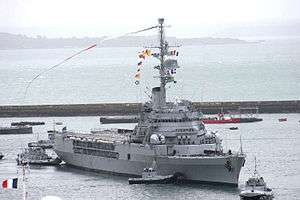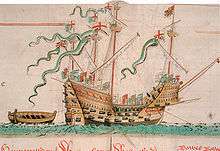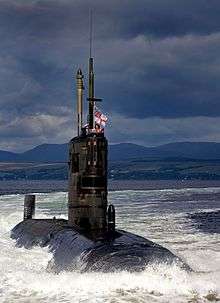Pennant (commissioning)

The commissioning pennant (or masthead pennant) is a pennant (also spelled "pendant") flown from the masthead of a warship. The history of flying a commissioning pennant dates back to the days of chivalry with their trail pendants being flown from the mastheads of ships they commanded. Today, the commissioning pennants are hoisted on the day of commissioning and not struck until they are decommissioned. Some navies have a custom of flying a "paying off" or "decommissioning pennant," the length of which often reflects the length of service of the warship.
History

It is said that the custom of wearing a pennant at the masthead of men-of-war stems from Tromp’s broom and Blake’s whip. In the 1650s the Dutch Admiral Tromp lashed a broom to his masthead as a sign that he had swept the British off the seas. In reply the British Admiral Blake hoisted a whip to the masthead to signify that he would whip the Dutchman into subjection. However, records show that pennants were in use well before this period as the mark of a warship.[1]
In the days of chivalry, knights and their squires carried pennons and pennoncells on their lances, just as men-of-war fly pennants from their masts. Records show that pennants were in use in the 13th century, when merchant ships were commandeered during war and placed in command of military officers, who transferred their trail pendants from their lances to the mastheads of the ships they commanded.[1]
The pennant is an evolution of old "pennoncell", that in the Royal Navy used to consist of three colours for the whole of its length, and towards the end left separate in two or three tails, and so the tradition continued until the end of the Napoleonic Wars when the Royal Navy adopted the style of pennants used by the service to this day. Pennants have been carried by men-of-war from the earliest times, prior to 1653 at the yard-arm, but since that date at the maintopgallant masthead.[2]
Today the pennant is hoisted on the day a warship or establishment commissions and is never struck until the day of decommissioning. It is, however, displaced by Royal Standards and the personal or distinguishing flags or pennants of commodores and admirals. In Navy ships the pennant is flown at the masthead, for which reason it is also commonly referred to as a masthead pennant.
Commissioning pennant
The commissioning pennant reflects the fact that the ship is a ship of war, and is flown until the ship is decommissioned. It is generally taken to signify the commissioned status of the warship, although it is the captain of the ship who holds the commission, and not the ship . In some navies, the commissioning pennant is used in addition to represent the personal authority of the captain, although it is flown continuously aboard the ship whether the captain is aboard or not.
Royal Navy

In the Royal Navy the commissioning pennant is flown continuously in every ship and establishment in commission unless displaced by a senior officer's Rank flag. The masthead pennant is a cross of St George in the hoist and a white fly.[3] Formerly, when the Royal Navy was divided into red, white and blue squadrons, there were four different pennants in use, the colour of the fly of three of the pennants corresponding with the colour of the squadron ensign, and a fourth for ships on independent commission (i.e. not attached to a squadron, therefore directly under the command of the Admiralty in London), with the fly containing (from top to bottom) red white and blue in a triband form (such ships would wear the red ensign). Modern commissioning pennants are significantly shorter than in previous centuries - typically 1m in length and only 10 cm at the hoist, tapering to a squared-off point.[3]
A boat carrying a captain of one of Her Majesty's ships will on ceremonial occasions fly a commissioning pennant from the bows of the boat as a symbol of his authority.
Hellenic Navy
In the Hellenic Navy, the commissioning pennant (Greek: Επισείων Πολεμικού Πλοίου, means Warship Pennant) blue coloured, has shape of isosceles triangle elongated, bearing a white cross near the base of the triangle. The flag has typically base to length (height of triangle) 1 to 20. The cross has arms width 1/5 base length and each arm length 3/5 of base length. The pennant flown on the top of mainmast.
United States Navy
The commissioning pennant of the United States Navy is "blue at the hoist, bearing seven white stars; the rest of the pennant consists of single longitudinal stripes of red and white."[1] Ships of the United States Navy fly the commissioning pennant from the moment of commissioning until the decommissioning ceremony. The ensign, jack and commission pennant are hoisted directly after the reading out of the commissioning order and struck as the final act before the captain declares the ship decommissioned. The USN uses the pennant as the symbol of the commanding officer.[4]
Paying-off pennants

It is the custom in many navies for a ship which is "paying off" to wear an extremely long commissioning pennant, which is normally at least the length of the ship, and the length of which reflects the length of service. This is in contrast to the modern practice of using pennants of not more than one or one-and-a-half metres for convenience.
Formerly a ship "paid off" each time she returned home after a commission overseas: the term refers to the fact that sailors were not paid until the ship returned home, to avoid desertion. The bible of Royal Navy traditions and slang, Covey Crump, emphasises:
- "It should be borne in mind that the commission referred to is the length of time the ship's company has been abroad, not the ship herself: when a ship recommissions abroad a fresh commission is started; thus a commission of longer than 2¾ years is exceptional."[5]
This custom is maintained in the United States Navy, where the paying-off pennant is known as the "homeward-bound pennant". Nevertheless, present usage in the Royal Navy has degenerated to using paying-off pennants only as part of a ship's decommissioning ceremony.
| Wikimedia Commons has media related to Commissioning pennants. |
See also
- Flag terminology
- Maritime flag
- French ensigns
- Clean sweep (naval), involving the use of a broom
References
- 1 2 3 "Commissioning Pennant". Naval History and Heritage Command. Department of the Navy. 10 April 2001. Retrieved 11 March 2011.
- ↑
 One or more of the preceding sentences incorporates text from a publication now in the public domain: Swinburne, H Lawrence (1911). "Flag". In Chisholm, Hugh. Encyclopædia Britannica. 10 (11th ed.). Cambridge University Press. p. 459.
One or more of the preceding sentences incorporates text from a publication now in the public domain: Swinburne, H Lawrence (1911). "Flag". In Chisholm, Hugh. Encyclopædia Britannica. 10 (11th ed.). Cambridge University Press. p. 459. - 1 2 "Ship's badges and flags". Royal Navy. Ministry of Defence. Retrieved 11 March 2011.
- ↑ McMillan, Joe (2001). "Commissioning pennant". Flags of the World. Retrieved 11 March 2011.
- ↑ "P. A. L. O - Putty (Pendant)". Royal Navy. Ministry of Defence. Archived from the original on 2011-03-20.

